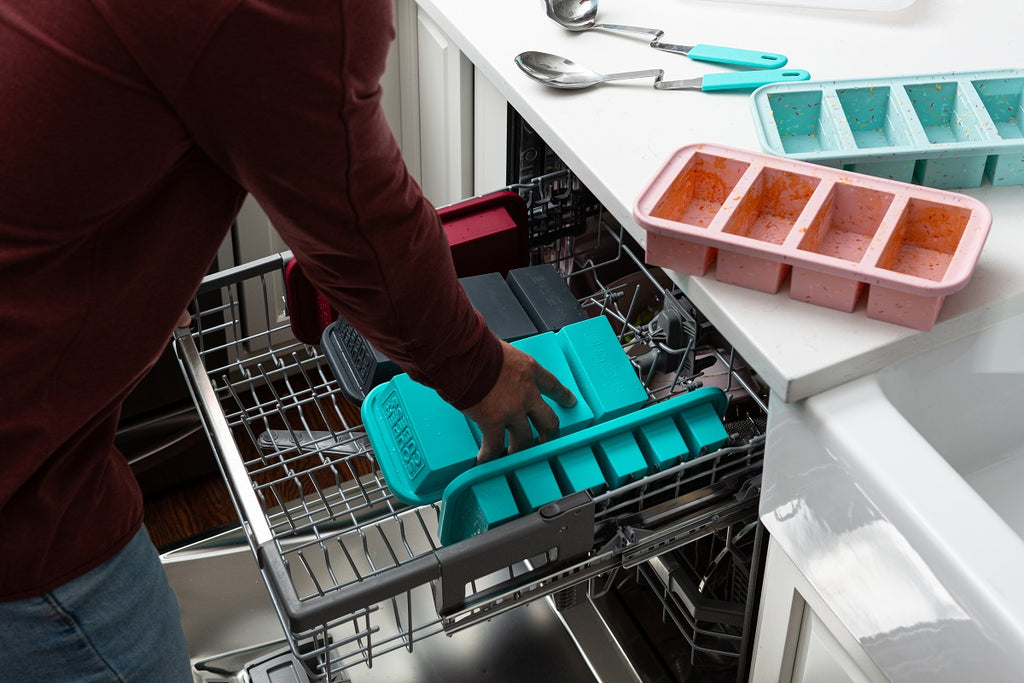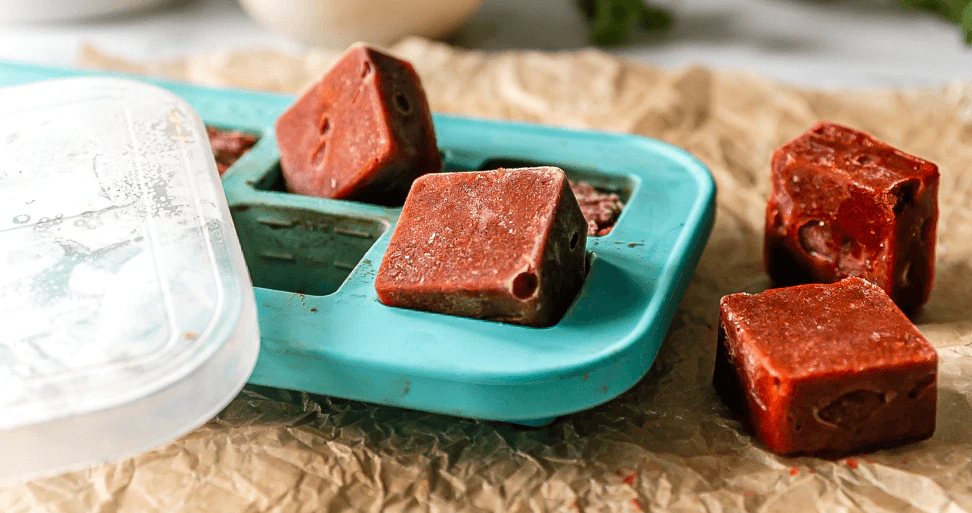
Our kitchen tools work just as hard as we do when it comes to cooking. Knives get dull from slicing, dicing, and mincing. Once shiny baking sheets turn greasy and brown from round after round of roasted vegetables and your family’s favorite chocolate chip cookies. And those silicone spatulas, muffin tins, and Souper Cubes trays that you rely on for prepping — and freezing — meals? They get coated in oil and sauce that starts to leave sticky residue, stains, and smells.
Just like knives need sharpening and baking sheets require some elbow grease, cleaning and maintaining your silicone cooking tools call for equal parts know-how and technique. When you’re constantly using your silicone mats and molds, it’s normal that you’ll have to move beyond regular scrubbing to get them back to tip-top shape.
What Is Silicone?
There are a handful of materials that are truly indispensable in the kitchen and one of them is food-safe silicone. Silicone is a man-made material that’s flexible, yet durable. It’s commonly used to make tools that are best when nonstick — for example, baking mats, cooking utensils, and ice cube trays. Because it’s also freezer and heat-safe, silicone is the ideal material for Souper Cubes freezing trays, since it allows you to safely chill, store, and reheat your food.
Over time, silicone can start to absorb grease and oils from those foods, especially when exposed to heat, which causes the silicone molecules to expand. Once that happens, running your silicone tools through the dishwasher as usual may not be enough to remove the buildup. But there’s no need to toss or replace them — they just need a more thorough cleaning.
How To Clean Silicone
One of the best features of silicone is that it doesn’t require daily special care. Unlike materials such as cast iron and wood, it can go straight into the dishwasher. We recommend washing your Souper Cubes trays after every use to make sure they’re as clean as possible. When buildup starts to happen, however, there are a few extra steps you can take to restore them.
For General Everyday Cleaning

A strong degreasing dish soap is usually all you need for regular cleaning and maintenance of your silicone kitchen products. You can hand wash your Souper Cube trays and lids, but we generally recommend dishwashing.
Tools Needed:
- Dishwasher
- Unscented dish detergent
Instructions:
- Place your silicone trays in the dishwasher. Run on a normal cycle as you would for day-to-day dishwashing (Yes, it’s that simple!). The silicone trays can be placed in the bottom and top of the dishwasher.
- For trays that were frozen or baked with heavily scented or staining foods such as tomatoes, onion, ginger, seafood, and turmeric, use a heavy or pots/pans cycle.
If you don’t have access to a dishwasher and your silicone items require deeper cleaning, soaking them should do the trick.
Tools Needed:
- Degreasing dish soap
- Nonabrasive sponge
- Optional: Lemon juice
Instructions:
- Add a teaspoon of dish soap to your sink (with the stopper plugged in) or a heat-proof container large enough to fit your silicone tools.
- Fill the sink or container with very hot water. You can optionally add some lemon juice to help cut through the grease.
- Place the silicone into the water and allow them to soak for a minimum of 1 hour.
- Add 1 to 2 drops of dish soap to a nonabrasive sponge and use it to scrub the silicone.
- Rinse with hot water and let it fully dry before using.
For Removing Stickiness
One of the top issues that home cooks experience with silicone is stickiness, especially if you bake with it. That’s because oil and grease can get baked into the surface, leaving a tacky film that regular washing isn’t always powerful enough to remove. If that’s the case, boiling the silicone molds in hot water or placing them in a heated oven will usually do the trick.
Heating in the Oven
Tools Needed:
- Degreasing dish soap
- Nonabrasive sponge
- Baking sheet (optional)
Instructions:
- Preheat your oven to 350°F.
- Rinse the silicone in hot water and clean it with dish soap and a nonabrasive sponge to remove any remaining oils.
- Place the silicone directly into the heated oven or put it on a baking sheet and place that on the rack
- Bake for 15 to 20 minutes to loosen the sticky spots. Carefully remove the silicone, using a pair of tongs or kitchen mitts to pull it out if you placed it directly into the oven.
- Once the silicone tray is cool, wash it again with soap and hot water.
Let fully dry before using.
Boiling in Hot Water
Tools Needed:
- Large pot
- Tongs
- Degreasing dish soap
- Nonabrasive sponge
Instructions:
- Bring a large pot of water to a boil.
- Carefully place the silicone into the pot and let boil for 10 to 15 minutes.
- Turn off the heat. Use a pair of tongs to safely remove it from the pot and place it in the sink.
- Add 1 to 2 drops of dish soap to a nonabrasive sponge and use it to scrub the silicone.
- Rinse with hot water and let it fully dry before using.
Using a Baking Soda Paste
If any stickiness remains after boiling or heating, try this additional method.
Tools Needed:
- Baking soda
- Degreasing dish soap
Instructions:
- Form a paste with the baking soda and water and use it to gently scrub the tray.
- Rinse off and wash with soap and hot water.
- Let fully dry before using.
For Removing Strong Scents
To clear your silicone of lingering smells, there are two recommended methods. Baking in the oven is highly effective, but only works with 100 percent silicone products, such as Souper Cubes, that can withstand high heat. Otherwise, you can opt for the baking soda method.
Heating in the Oven
Tools Needed:
- Degreasing dish soap
- Nonabrasive sponge
- Baking sheet (optional)
Instructions:
- Preheat your oven to 350°F.
- Rinse the silicone in hot water and clean it with dish soap and a nonabrasive sponge to remove any remaining oils.
- Place the silicone directly into the heated oven or put it on a baking sheet and place that on the rack
- Bake for 30 minutes. Carefully remove the silicone, using a pair of tongs or kitchen mitts to pull it out if you placed it directly into the oven.
- Once slightly cooled, check to see if it’s still smelly or sticky. If so, return to the oven for another 10 minutes.
- When you no longer smell any lingering aromas or feel any stickiness, let the silicone fully cool, then wash again with soap and hot water.
- Let fully dry before using.
Drying in the Sun
Tools Needed:
- Degreasing dish soap
- Nonabrasive sponge
Instructions:
- Rinse the silicone in hot water and clean it with dish soap and a nonabrasive sponge.
- Set out the silicone in direct sunlight for several hours.
- Once you no longer smell any lingering aromas, wash again with soap and hot water.
- Let fully dry before using.
Cleaning With Baking Soda
Tools Needed:
- Baking soda
- Dishwashing gloves
Instructions:
- Combine the baking soda with just enough hot water to form a thick paste.
- Wearing dishwashing gloves, spread the baking soda paste across the surface and rub it into the silicone.
- Let the paste sit on the tray for at least 30 minutes.
- Rinse with hot water and let it fully dry before using.
For Removing Stubborn Stains

Whether you’re using your silicone spatula to stir marinara sauce or freezing chilis and stews in your Souper Cubes, stains can occur. Cleaning with hydrogen peroxide will help remove both discoloration and sticky residue.
Tools Needed:
- 3% hydrogen peroxide
- Large container
- Optional: Degreasing dish soap and nonabrasive sponge
Instructions:
- Place the silicone items in a container.
- Add enough hydrogen peroxide to cover the silicone.
- Soak overnight.
- Remove the silicone and rinse with hot water. You can also wash with dish soap and nonabrasive sponge before rinsing.
- Let fully dry before using.
Drying and Storing Silicone
Allowing your silicone kitchen tools to fully dry before using or storing them is a small step that makes a big difference in maintaining their quality. Storing damp silicone tools in cabinets or shelves with limited air circulation can lead to the growth of mold and bacteria, which not only affects the taste and safety of your food, but can slowly degrade the material. No matter which cleaning method you’re using, it’s important to let them fully air dry before you put them away.
Commonly Asked Questions

Do Souper Cubes stain?
Souper Cubes were designed to be fairly stain resistant (we’ve even had them stain tested!), especially if you wash the trays and lids properly after every use. If stains do form, cleaning with hydrogen peroxide should help remove them.
How do you clean sticky silicone cookware?
Residue buildup on silicone cookware is natural and comes with regular use. You can try any of the above cleaning methods to degrease them.
What is safe to clean silicone?
Silicone is incredibly resilient and durable, so you don’t need harsh chemicals or abrasive scrubbing to get them clean — in fact, you should avoid both of these. Instead, opt for regular dish soap and a nonabrasive sponge for the day-to-day cleaning of your silicone kitchen tools. We prefer to use unscented detergent and soap when cleaning silicone. You can also place your Souper Cubes in the dishwasher alongside your everyday dishes. For lingering smells or stains, baking soda, hydrogen peroxide, or your oven are all powerful enough to do the trick.
The Importance of Maintaining Your Silicone Tools

By properly cleaning and caring for your silicone kitchen tools, you’re not just maintaining their appearance — you’re ensuring they continue to serve you well in every meal you prepare. Whether it’s a regular run through the dishwasher, a gentle scrub for those tougher spots, or an overnight soak to tackle lingering stains, these simple methods can extend the life of your silicone.
Silicone’s durability and flexibility are what make it a kitchen favorite and with the right care, these tools can last for years, making your cooking and meal prep experience smoother and more enjoyable. With these cleaning methods in your back pocket, you can reach for that trusty spatula or those perfectly portioned Souper Cubes knowing they’re ready to help you create — or store — something delicious.










We would love to hear your ideas or better yet, post a photo of your cubes organized in our Freezer Meals & Recipes Facebook Group!